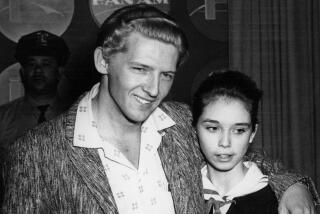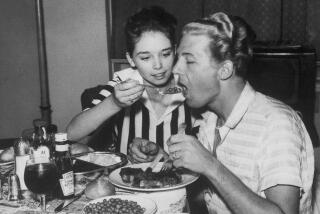Ole King Soul
The first name that must be mentioned in any discussion about declaring a “king of soul” should be Ray Charles, whose landmark recordings on Atlantic in the ‘50s and ‘60s defined the passionate, gospel-based singing style that stands as one of the most absorbing in all of contemporary pop.
Next should be Sam Cooke, who sang with sweet, angelic grace and added a touch of sex appeal and pop accessibility to the soul tradition without sacrificing its character. Though his career ambitions sometimes led him into anonymous, Top 40 directions, Cooke’s early gospel recordings and “Live at the Harlem Square Club” album remain soul classics.
Then there’s Otis Redding, whose “(Sittin’ on) The Dock of the Bay” and “I’ve Been Loving You Too Long (To Stop Now)” conveyed marvelously the tenderness and heartache that rests at the foundation of soul music.
Finally, there’s Al Green, who boldly extended the soul sensibilities into the ‘70s and ‘80s with a series of recordings, from “Tired of Being Alone” to “Belle.” In those recordings and subsequent gospel works, the nine-time Grammy winner redefined soul music in ways that have served as a model for subsequent generations of vocalists. You hear echoes of his style in everyone from D’Angelo to Tony Toni Tone’s Raphael Saadiq.
If the “king of soul” debate were put to a vote, the critical consensus might well favor Charles, Cooke and Redding in that order, because they were the forefathers. My vote, however, goes to Green as the greatest of them all. Exhibit A is “Anthology,” the sparkling new four-disc set from Capitol’s the Right Stuff label. It is the essential Al Green collection, bringing together all the hits, from “Let’s Stay Together” to “I’m Still in Love With You,” that remain jukebox staples today.
But even these 61 live and studio recordings, which showcase his ‘60s and ‘70s work, don’t tell the entire story. Green has continued as a vital artist longer than any of his predecessors. Charles’ recordings since the mid-’60s have not been nearly as innovative or compelling as his earlier ones, and his live shows for years have tended to be flaccid.
Cooke and Redding may have been able to maintain or extend their visions, but tragedies short-circuited their careers. Cooke was 33 in 1964 when he was shot to death in a Los Angeles motel. Redding was just 26 when he died in a 1967 plane crash near Madison, Wis.
Green’s recording career began the year of Redding’s death when “Back Up Train” went to No. 5 on the R&B; charts, even though it was released by the tiny Hot Line Records. It was years before anyone recognized the point, but a torch had been passed.
Thirty years later, Green has not lost a step vocally. He remains as challenging and electric as ever on stage, whether in a gospel or pop setting.
At the heart of his art is a singing style that is so constantly inventive that he seems like a magician, pulling pieces of vocal punctuation out of the air in ways that constantly surprise and amaze.
Like Michael Jordan driving the lane, Green can come at you in so many ways. In a single song, he can employ sudden bursts of falsetto or a teasing growl. He can move deftly from an almost conversational tone to a whisper. He can be teasing, seductive, playful, wry, wholly engaged or strangely reserved.
The Green hits on “Anthology” have been recycled endlessly on greatest-hits packages. What this box set reveals is the remarkable consistency of his larger body of work--from the relatively obscure but scorching “Tomorrow’s Dream” to a 1971 interpretation of the Doors’ “Light My Fire” that is so radical and assured that you’d swear he had written the song.
Where you can isolate creative peaks and valleys in most box sets, you can turn to virtually any track in this anthology and be rewarded with a vocal that seemingly represents Green at the top of his form.
Despite the early hit on Hot Line, Green’s career didn’t flourish until record producer Willie Mitchell brought him to Hi Records in Memphis two years later and put the Arkansas native together with a splendid rhythm section that gave him the same kind of supportive and inspiring musical environment that Redding enjoyed at Stax Records with Booker T. & the MGs.
“The biggest thing I had to do with Al was soften him up because he had so much Sam Cooke in him,” Mitchell says in the album’s liner notes. “He wanted to sound like Otis Redding, he wanted to sound like Sam & Dave. I said, ‘We don’t need that. You can’t compare with these guys. You need to be smooth and sweet, you don’t need to scream.’ And finally I got him to settle down.”
Green, writing most of his own material, and Mitchell would produce a memorable body of work, highlighted commercially by “Let’s Stay Together,” which would stay at No. 1 on the R&B; charts for nine weeks--longer than any other single in the ‘70s.
At Hi, Green sold an estimated 30 million records, but he began shifting in the late ‘70s toward gospel music and eventually turned his back for years on the pop world. Answering what he has described as a call from God, Green became pastor of the Full Gospel Tabernacle Church in Memphis.
Without abandoning gospel, Green has returned in recent years to recording pop music. He teamed with Annie Lennox in 1988 for the Top 10 hit “Put a Little Love in Your Heart,” and his 1992 duet with Lyle Lovett on “Funny How Time Slips Away” won a Grammy for pop collaboration.
About resolving his conflict between gospel and pop music, Green said last year, “I can’t put myself in one little teardrop and say this is Al Green. I can’t cut myself off from my whole river of tears. ‘Love and Happiness’ is truly me and ‘Amazing Grace’ is truly me. You add them up and it’s the total person.”
You add them up and you’ve got the king of soul.
(BEGIN TEXT OF INFOBOX / INFOGRAPHIC)
**** AL GREEN “Anthology,” The Right Stuff
More to Read
The biggest entertainment stories
Get our big stories about Hollywood, film, television, music, arts, culture and more right in your inbox as soon as they publish.
You may occasionally receive promotional content from the Los Angeles Times.






